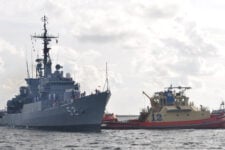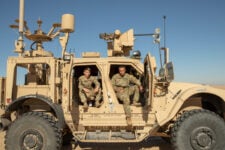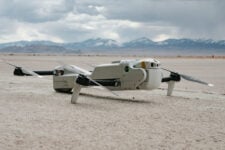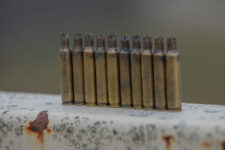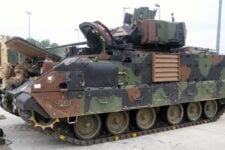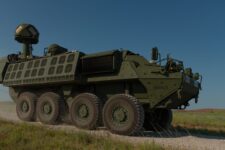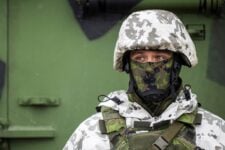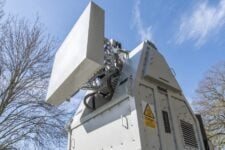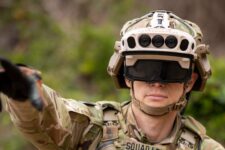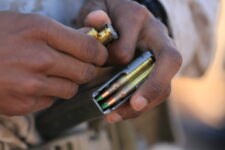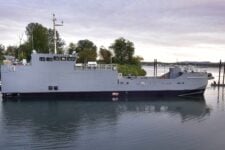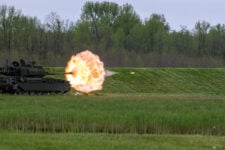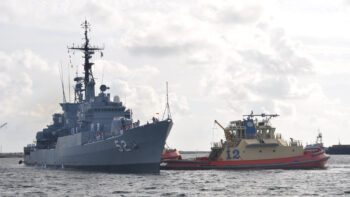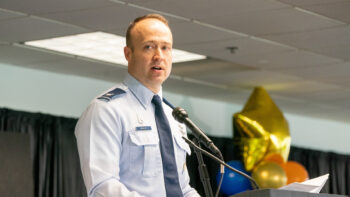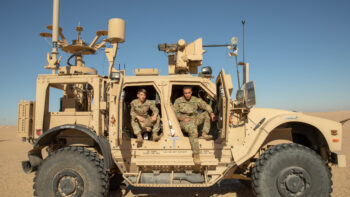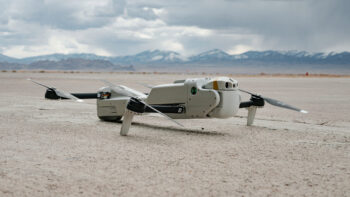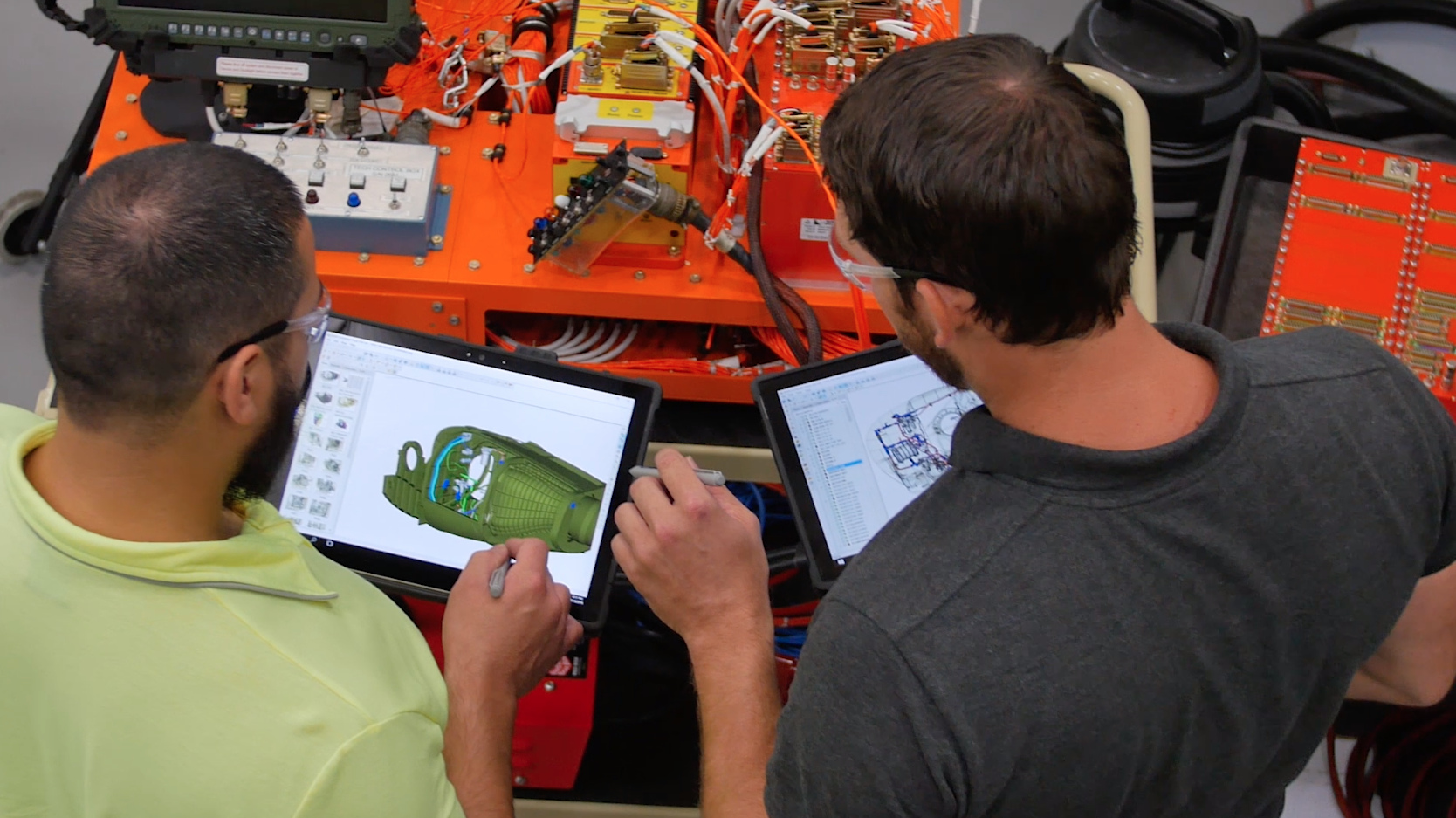
Bell’s Systems Integration Laboratories are designed to quickly integrate and test mission and air vehicle system capabilities. Photo courtesy of Bell.
The Army has been clear that its two Future Vertical (FVL) programs are critical to maintaining U.S. military dominance over near-peer competitors by radically improving upon the current fleet’s speed, range, agility, power, durability, versatility, and sustainability. A chief enabler of FVL is the application of digitally connected environments, often known as digital threads, in development of highly capable, forward-looking platforms that will help Army aviation keep its edge.
Digital capabilities connect all stages of program development from design to build and verification. For the two FVL programs—the Future Long Range Assault Aircraft (FLRAA) and Future Attack Reconnaissance Aircraft (FARA)—digital threads ensure that the platforms are combat ready through the efficient integration of mission equipment, avionics systems, and all the required software packages needed for a safe, effective, and lethal weapons system.
It is via this digital approach, as well as application of a Modular Open Systems Approach (MOSA), that the Army can avoid the traps of earlier procurements that blew their budgets and schedule, failed to overcome immature technology intended for those platforms, and ended up being canceled. Instead, digital design and development decrease programmatic risk by making it possible to continually add technological and capability improvements throughout a weapons system’s lifecycle to counter whatever China and Russia will throw at the U.S. in the Great Power Competition.
“Most importantly, digital approaches in defense acquisition provide a tool set to help reduce uncertainty and iterate and field capabilities more quickly,” states the October 2021 report from the Center for Strategic and Budgetary Assessments entitled, Living Within One’s Means: Revisiting Defense Acquisition and Affordability—A Case Study of the Army’s Future Vertical Lift Program.
“Instead of envisioning digital approaches as a means to reach new heights of affordability for defense programs, the best result from their use will be to avoid the massive cost growth that has plagued defense acquisition programs in the post-Cold War era,” states CSBA, an independent, nonpartisan policy research institute. “Applying this approach, (and) if the Army can live within well-estimated means, stick to their plan, and pace advancing threats, FVL could become one of the most successful defense acquisition programs of the 21st Century.”
Bell hones its digital threads in its system integration labs
The Army’s embrace of digital design and advanced manufacturing is making it possible for the service to modernize its aviation forces for the first time in more than 40 years, with FLRAA leaping past the Black Hawk for air assault and transport, and FARA filling the gap left by the retirement of the OH-58 Kiowa Warrior for a scout and recon force.
Long-range air assault and attack/reconnaissance have long been Army core competencies, and FLRAA and FARA are being developed to maintain that dominance in a peer/near-peer competitive environment and ensure global relevance at the speeds and ranges required for multi-domain operations.
Bell’s FVL programs—the tiltrotor-based Bell V-280 Valor for FLRAA and the Bell 360 Invictus for FARA—are digitally native programs specifically designed for relevance today and throughout the decades of expected program performance.
Bell leverages the digital enterprise for both the V-280 and Bell 360 through what it calls its Systems Integration Laboratories (SILs).

Becky Stiles, Director of Vehicle Systems at Bell.
“The SILs are the key to what we’re doing as they bring all the digital elements together in the physical to perform the fail, test, validate cycle efficiently before moving onto the weapon system,” said Becky Stiles, director of Vehicle Systems at Bell. “Having the actual flight controls, actuators, generators, and other systems in the lab lets us address items like human factors, fault tolerance, algorithm, and validation extremely early in the process.”
To speed the iteration of software, the company has aircraft-representative subsystem benches and wiring that allow it to develop solutions with partners like Moog, Lockheed Martin, Astronics, and Rolls Royce, and to insert upgrades and acquire the customer’s subjective, operational feedback. The labs also let Bell tie mission systems to flight controls and avionics to bridge the gap to autonomy much faster.
“We go through the loop of idea-to-iterate-to-validate to get a capability on the aircraft or in the program much more efficiently and affordably so we can drive down program costs from the outset,” said Stiles. “And then in terms of reliability and safety—all the airworthiness qualification levels we need to address—we can do much of that in that digital environment before we ever have to put something on an aircraft. We know that once it leaves the lab that modifications get more expensive, so we drive down the risk as much as possible before it ever leaves that environment.”
The SILs are designed to quickly integrate and test mission and air vehicle system capabilities. The labs contain enough space and provision for drive stands, electrical power, test benches, classified systems, and more to ensure a thorough and aircraft-representative environment where Bell can quickly identify integration issues and verify fixes.
By implementing a design-as-built methodology that digitally connects the entire program throughout its lifecycle, Bell has increased its ability to collaborate in real-time with program partners and the Army. This method accelerates decision-making among distributed teams using a common, secure data environment that creates a singular source of data for the program leading to reduced assembly, rework time and cost.
Proving out the digital models with the V-280 Valor
This was proved during the recently completed Joint Multi-Role Technology Demonstrator (JMR TD) program, which enabled rapid technology maturation and flight testing for the Bell V-280 Valor as part of the FLRAA program.
“The SIL allowed us to close the loop all the way up into the user community to ensure we are meeting requirements,” said Stiles. “If a requirement change is identified , we can quickly and accurately give them the impact of the change.”
The JMR TD SIL showed its worth by helping to turn out timely upgrades that led to a more affordable V-280 moving forward. For example, during the JMR TD program, the Team Valor teammates worked several avionics-upgrade cycles that focused on adding in the Pilotage Distributed Aperture (PDAS) system, a Tactical Common Data Link (TCDL), along with several software improvements related to pilot situational awareness. Those upgrades were accomplished within the period of performance, and involved both test and engineering teams working in concert to verify safety and performance through testing, flight rehearsals, and test-card development.
Said Stiles: “The focus of our engineering and systems integration lab teams is on meeting the customer goals in how they use their platforms for operations. Our experience shows that as the Army becomes familiar with the capabilities of FVL aircraft, they will learn and want to do more.
“We can immediately put that thinking back into our digital thread and model and see what the impacts are going to be through the lab. Or, if they need to do an upgrade, we can either give them that capability faster or we can start testing to explore the ability to expand the envelope from our original requirement.”
Building infrastructure for FVL
Because of the importance of the SILs to continued development of the flight-proven V-280 and the high speed Bell 360, Bell continues to invest in them.
In July 2021, Bell announced plans for a SIL at the Bell Flight Research Center (FRC) in Arlington, TX. This state-of-the-art facility will support testing and verification for both FLRAA and FARA, with each program having their own dedicated footprint in the FRC.
This new facility is being built to perform risk reduction, integration, verification and validation testing on air vehicle and mission systems, as well as the software needed to meet requirements for all FVL weapon-system-development programs.
“Our team has proven we are able to deliver leap-ahead, flight-proven performance and successfully complete rapid design, build and rigorous flight test programs,” said Keith Flail, executive vice president, Advanced Vertical Lift Systems at Bell. “This SIL is the next step in bringing both FLRAA and FARA solutions to fruition for the U.S. Army.”
In another Bell infrastructure investment, the company began operations in 2021 of a state-of-the-art Manufacturing Technology Center (MTC) in Fort Worth, TX. The MTC is an innovative proving ground where Bell now tests and refines technologies and processes while demonstrating readiness and ability to successfully build and support FVL aircraft and other new products. It offers a digitally connected space for collaboration between Bell teams in an environment that promotes smart risk taking. New systems are being tested and vetted for production suitability before being introduced to Bell’s future factories.
The goal of these facilities is to reduce risk on the V-280 and Bell 360 programs for the Army FVL competitions. And through the JMR TD program, Bell has demonstrated that it can proactively manage risk, expand capability, and deliver stronger outcomes for its Army partners.
“The key is identifying the risks and prioritizing requirements challenges as early as possible, and then activating corrective-action plans that come from a holistic operational perspective for both hardware and software,” said Stiles. “The sooner we can get items into the lab with the customer, the better off we’re going to be.”
Everything is in alignment with the Army’s timeline for Engineering and Manufacturing Development, first flight, testing, and First-Unit Equipped phases. Bell is already in those digital environments with the Army and its partners working toward program-of-record-level development.
MOSA is the enabler behind digital design
Bell’s extensive use of digital-design threads goes hand in hand with its embrace of the Army’s MOSA architecture. According to the CSBA report, MOSA is the key enabler that will make it possible for the Army to integrate mission systems, weapons, and effectors across the FVL family of systems.

Bell’s extensive use of digital-design threads goes hand in hand with it’s embrace of the Army’s MOSA architecture. Photo courtesy of Bell.
Maj. Gen. Walter Rugen, FVL Cross Functional Team director, commenting on the CSBA findings, specifically called out the importance of open systems.
“MOSA will be a game changer on many levels,” he said. “MOSA is going to help the Army live within its budget by fostering a competitive environment with industry that will drive down costs while allowing the warfighter to rapidly upgrade mission systems creating real time dilemmas for our adversaries.”
For its part, Bell is both bound and inspired by the MOSA requirements—the FVL Architecture Framework, the FAF. The company is deriving standards from the FAF and putting those into its system requirements and pushing them out to its suppliers. That lets it build in growth opportunities, upgradability and capability while also providing off-ramp paths for obsolescence up front, saving time and money on the back end for things like regression testing.
“In the past, developing a software upgrade would be fairly expensive because you would have to qualify the entire integration tail that went along with it,” said Stiles. “Now we are able to package the software and hardware in such a way that we understand where those integration boundaries stop and start, allowing the customer and us to compartmentalize and get the Army the capability they need faster and more affordably.”
